水溶性聚合物
- 格式:ppt
- 大小:771.50 KB
- 文档页数:59
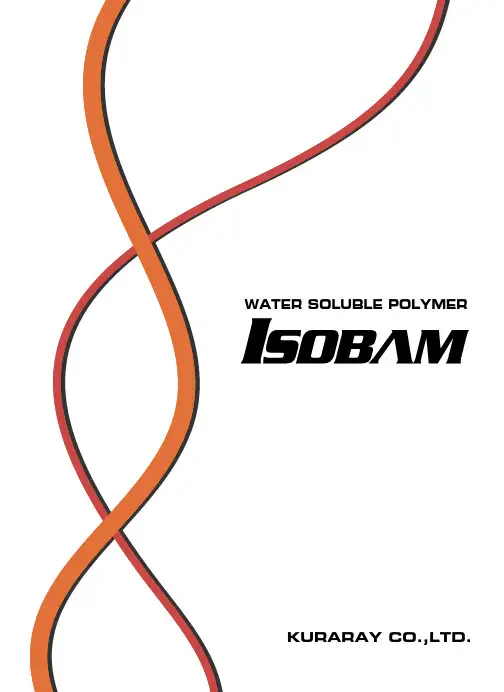
WATER SOLUBLE POLYMER KURARAY CO.,LTD.• AdhesivesSBR emulsion type Polyvinyl acetate type• Protective colloidsVinyl acetateAcryloyl monomerVinyl chlorideMicro-capsule for pressure sensitive paper• BindersBinder for ceramic powder Binder for solid catalyst• Metal processing oilsLubricant for forgingHardening agent for steel• Super absorbent polymersChemical pocket heater Sealing materials• DispersantsWater-reducing agent for cement Scale inhibitorDispersing agent for pesticide Water soluble paint• Coating for papersCoating agent for thermal paper• Plastic modifications1“ISOBAM” isISOBAM is the trade name of an alternative copolymer of isobutylene and maleic anhydride developed by KURARAY using their POVAL ®(polyvinyl alcohol)technology.ISOBAM is an alkali water soluble polymer with outstanding characteristics which have never been acquired by conventional water soluble polymers such as polyvinyl alcohol and cellulose derivatives.ISOBAM is a white powder in appearance. It is generally used as a water soluble polymer reacting with sodium hydroxide, ammonia and amine.Various useful reactants are obtained by the reaction of I SOBAM with alcohol,amine and epoxy compounds. These can be applied to resins and plastics.2Weight- average molecular weightGrades of “ISOBAM”Physical properties of “ISOBAM”M o l e c u l a r W e i g h t10101010Molecular weight5,500 6,50055,00065,00080,00090,000160,000170,000300,000350,00055,00065,000160,000170,00055,00065,00080,00090,00012200 mesh 88%12200 mesh 88%12200 mesh 88%12200 mesh 88%12200 mesh 88%12200 mesh 88%12200 mesh 88%12200 mesh 88%20 mesh95%0.4 0.70.3 0.50.3 0.50.3 0.50.3 0.50.3 0.50.3 0.50.3 0.50.3 0.50.60.9544443Standard type of “ISOBAM”Differing from conventional water soluble polymers, ISOBAM is used by reacting with alkali.These alkali solutions can be easily modulated from low viscosity to high viscosity and from acidity to alkalinity.Standard type of ISOBAM is used as binders with excellent heat resistance, and hardness.Also Standard type has an excellent dispersing effect with high functionality of the carboxyl group which is aligned side by side in the molecule.I SOBAM-600 is the lowest molecular weight of all I SOBAM, with approximately 6,000 of molecular weight.ISOBAM-600 is used as a dispersing agent and surface active agent. ISOBAM-600CAS NO. 26426-80-2TSCA RegisteredWater-reducing agent for cementScale inhibitorDispersing agent for pesticideCharacteristics etcEffective to use as solid.Delayed action by dissolving in cement.Function as chelator of metal ion inwater. ( CaWhen dispersed into water, it collapsesgradually.4These grades have molecular weight, ranges from middle to high.With features such as hardness and toughness, they are mainly used as bindersand protective colloids.ISOBAM-04,06,10,18Protective colloid of polymerizing emulsionEmulsion type of adhesive for woods and papers Water based binders for ceramic powdersCoating agent for thermal paperMicro-capsule for pressure sensitive paperLubricant for forging Hardening agent for steelCharacteristics etcAdd hardness and tackiness to polyvinyl acetate adhesive.Add high viscosity to acrylic emulsion.SBR emulsion type of adhesive.Function as dispersant for inorganic filler.None formaldehyde adhesives.Moderate decomposition.No ash.Improvement of strength of raw compound.Water resistance together with polyvinyl alcohol.Maintaining capsule hardness.Excellent emulsifying dispersion property.Maintaining viscosity.Moderate decomposition resistance property.Excellent membrane construction to surface of metal.Moderate cooling curve.5Amide-ammonium salt type of “ISOBAM”I SOBAM-104 and 110 are Amide-ammonium salt types of I SOBAM. These are ammonium modified products based on Standard type ISOBAM.They have features of Standard type of ISOBAM and are soluble in water.The pH of aqueous solution shows neutral.ISOBAM-104,110CAS.NO. 52032-17-4TSCA Under making application to TSCABinder for ceramic powderBinder for solid catalystWater soluble paintAromaticCharacteristics etcWater soluble.No ash.Good activation.Not easily broken for solid catalyst.Dispersion properties.Excellent membrane construction.Suitable for under coatings.Jelly type aromatic.Hardness and heat resistance togetherwith crosslinking agent at roomtemperature.6Imide type of “ISOBAM”ISOBAM-304 and 306 are Imide types of ISOBAM. These are imide degenerated products based on Standard type ISOBAM.They have the features of Standard type ISOBAM and are water resistance andheat resistance.ISOBAM-304,306CAS NO.89360-06-5TSCA Under making application to TSCA.Protective colloid for polymerizing VAc.Emulsion type of adhesive for woodCharacteristics etcAdd water resistance and hardness to adhesive of polyvinyl acetate.SBR emulsion type and polyvinyl acetate.Good water resistance.Good initial tackiness.Non formaldehyde adhesives.Instantaneous adhesion by uniting hydrogen bond utilizing imide group and aldehyde.7Crosslink type of “ISOBAM” is produced by both I SOBAM solution and crosslinking agent.Crosslink type of “ISOBAM”KI-GEL is the trade name of Crosslink type of ISOBAM.On contact with water, it rapidly absorbs water in the amount of 200 times its own weight.Once absorbed, minimual water is released even under a pressured condition.Excellent durability against heat, good stability in both hot water and cold water. KI-GELCAS NO. 39612-00-5TSCA Under making application to TSCAChemical pocket heaterSealing materialsCharacteristics etcGood stability in holding water.Good water release property as heated.Mixing gel powder into rubber or TPE.Good dispersion properties, higherexpansion pressure and high durabilityfor rubber or TPE.8Basic characteristic of “ISOBAM”(Tested by KURARAY)Decomposition properties of Standard type of ISOBAM compared with other polymers(Thermal gravity analysis, Heat-up rate 5/min)Decomposition properties of ISOBAM-104 and 110 compared with other polymers(Thermal gravity analysis, Heat-up rate 5/min)D e g r a d a t i o n o f W e i g h t (%)Temperature (°C)D e g r a d a t i o n o f W e i g h t (%)Temperature (°C)9Neutralization of ISOBAMMethod for Dissolving ISOBAM (Formulation)Place ISOBAM gradually into the requred alkali solution in a vessel. To avoid bumping, it is desirable to put vessel in cooling bath such as a "waterbath".Dissolve for 4 to 5 hours at 90 to 100with stirring.Cool the vessel to room temperature, replenish the vessel with the amount of water that has been lost during dissolving.In case of using ammonia aqueous solution for dissolving, it is desirable to dissolve in closed vessel such an "autoclave" to avoid an ammonia smell.Case 1: Preparation of ISOBAM-04 with NaOHfor 20% solid concentration.(= 0.8)ISOBAM-04:100gNaOH:51.88X0.8=41.50gDistilled water:(100+41.50)0.20-(100+41.50)=566.00gCase 2: Preparation of ISOBAM-304 with 25%-ammonia solution for 15% concentrationof ISOBAMconcentration of ISOBAM. (= 0.6)SOBAM-304:100gAmmonia solution:11.60X0.60.25=27.84gDistilled water:(1000.15)-(100+27.84)=538.83g Table 1 shows the required alkali quantity to dissolve 100 parts of I SOBAM powder for complete neutralization. (neutralization degree = 1)Definition for Degree of Neutralization()If all carboxyl groups are neutralized, it’s defined as=1pH of Alkali SolutionCan be controlled by changing alkali and degree of neutralization.The following pH range can be obtained by using NaOH and Ammonia.NaOH pH=3~12Ammonia pH=3~10Process for a dissolving ISOBAMTable 1: The amount of alkali quantity (unit : g)T e m p e r a t u r e (°C )Dissolving Time (hr.)10Dissolving speed of ISOBAM in a sodium hydroxide solutionNeutralization degree of ISOBAM-10:0.5, 0.6 and 0.8Concentration:20wt%Rotation speed of the stirrer:120 r.p.mT e m p e r a t u r e (°C )Dissolving Time (hr.)Neutralization degree of ISOBAM-304:0.6 , 0.8Concentration:20wt%Rotation speed of the stirrer :120 r.p.m11p HNeutralization degreep HNeutralization degreep HNeutralization degreep HNeutralization degree0.20.40.60.81.0pH - Neutralization degree curve (NaOH solution)pH - Neutralization curve (NH 4OH solution)12Concentration(%)V i s c o s i t y (c p s )Concentration(%)V i s c o s i t y (c p s )10100100010000100000Concentration(%)V i s c o s i t y (c p s)110100100010000Concentration(%)V i s c o s i t y (c p s )Viscosity-Concentration curve (NaOH solution)Standard type of ISOBAM (NH 4OH Solution. =0.8)Imide type of ISOBAM (NH 4OH Solution. =0.6)Standard type of ISOBAM (NaOH Solution. =0.8)Imide type of ISOBAM (NaOH Solution. =0.6)Viscosity-Concentration curve (NH 4OH solution)13Viscosity(cps)Neutralization degreeViscosity(cps)Temperature (°C)Viscosity(cps)101001000Neutralization degree Viscosity - Neutralization degree curve Viscosity - Temperature curve14hydroxide=0.8=0.8acetate=1.0acetate=1.0favorable poor badfavorablepoor badAll data presented herein is based on actual measurements perfomed by Kuraray Co., Ltd.All information contained herein is presented in good faith and without warrant.KURARAY CO., LTD. ACCEPTS NO LIABILITY FOR DAMAGE OR LOSS RESULTING FROM THE USE OR MISUSE OF THIS INFORMATION.Mixing property of ISOBAM solution and metal compoundMixing property of ISOBAM with other polymers1997.5(2,000) EHead Office :Isoprene Chemical DivisionMaruzen Bldg., 2-3-10, Nihonbashi, Chuo-ku, Tokyo 103Tel.81-3-3277-6654 Fax.81-3-3277-6718KURARAY AMERICA,INC.:200 Park Avenue New York, NY 10166Tel.1-212-986-2230 Fax.1-212-867-3543Du ¨sseldorf Office :Schiess-Strasse 68 40549 Du ¨sseldorfTel.49-211-53888-15 Fax.49-211-53888-48。
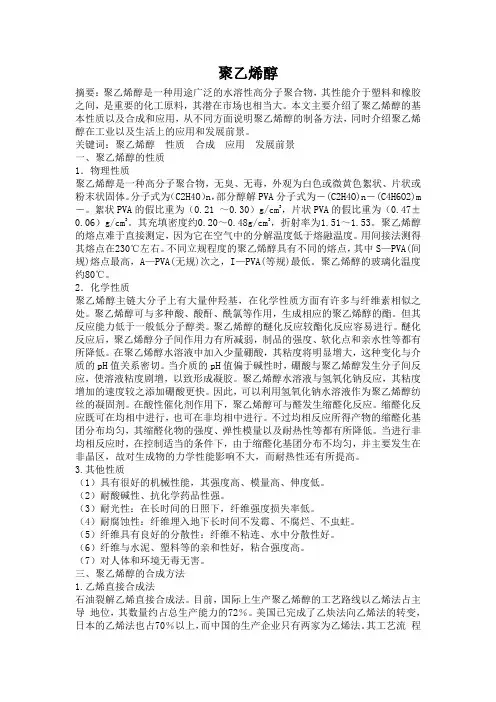
聚乙烯醇摘要:聚乙烯醇是一种用途广泛的水溶性高分子聚合物,其性能介于塑料和橡胶之间,是重要的化工原料,其潜在市场也相当大。
本文主要介绍了聚乙烯醇的基本性质以及合成和应用,从不同方面说明聚乙烯醇的制备方法,同时介绍聚乙烯醇在工业以及生活上的应用和发展前景。
关键词:聚乙烯醇性质合成应用发展前景一、聚乙烯醇的性质1.物理性质聚乙烯醇是一种高分子聚合物,无臭、无毒,外观为白色或微黄色絮状、片状或粉末状固体。
分子式为(C2H4O)n,部分醇解PVA分子式为-(C2H4O)n-(C4H6O2)m -。
絮状PVA的假比重为(0.21 ~0.30)g/cm3,片状PVA的假比重为(0.47±0.06)g/cm3。
其充填密度约0.20~0.48g/cm3,折射率为1.51~1.53。
聚乙烯醇的熔点难于直接测定,因为它在空气中的分解温度低于熔融温度。
用间接法测得其熔点在230℃左右。
不同立规程度的聚乙烯醇具有不同的熔点,其中S—PVA(间规)熔点最高,A—PVA(无规)次之,I—PVA(等规)最低。
聚乙烯醇的玻璃化温度约80℃。
2.化学性质聚乙烯醇主链大分子上有大量仲羟基,在化学性质方面有许多与纤维素相似之处。
聚乙烯醇可与多种酸、酸酐、酰氯等作用,生成相应的聚乙烯醇的酯。
但其反应能力低于一般低分子醇类。
聚乙烯醇的醚化反应较酯化反应容易进行。
醚化反应后,聚乙烯醇分子间作用力有所减弱,制品的强度、软化点和亲水性等都有所降低。
在聚乙烯醇水溶液中加入少量硼酸,其粘度将明显增大,这种变化与介质的pH值关系密切。
当介质的pH值偏于碱性时,硼酸与聚乙烯醇发生分子间反应,使溶液粘度剧增,以致形成凝胶。
聚乙烯醇水溶液与氢氧化钠反应,其粘度增加的速度较之添加硼酸更快。
因此,可以利用氢氧化钠水溶液作为聚乙烯醇纺丝的凝固剂。
在酸性催化剂作用下,聚乙烯醇可与醛发生缩醛化反应。
缩醛化反应既可在均相中进行,也可在非均相中进行。
不过均相反应所得产物的缩醛化基团分布均匀,其缩醛化物的强度、弹性模量以及耐热性等都有所降低。
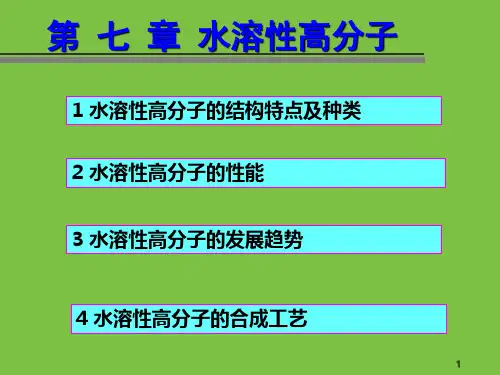
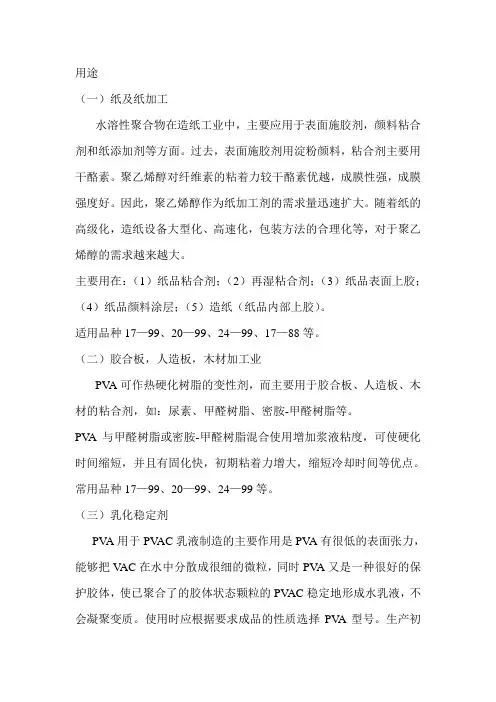
用途(一)纸及纸加工水溶性聚合物在造纸工业中,主要应用于表面施胶剂,颜料粘合剂和纸添加剂等方面。
过去,表面施胶剂用淀粉颜料,粘合剂主要用干酪素。
聚乙烯醇对纤维素的粘着力较干酪素优越,成膜性强,成膜强度好。
因此,聚乙烯醇作为纸加工剂的需求量迅速扩大。
随着纸的高级化,造纸设备大型化、高速化,包装方法的合理化等,对于聚乙烯醇的需求越来越大。
主要用在:(1)纸品粘合剂;(2)再湿粘合剂;(3)纸品表面上胶;(4)纸品颜料涂层;(5)造纸(纸品内部上胶)。
适用品种17—99、20—99、24—99、17—88等。
(二)胶合板,人造板,木材加工业PV A可作热硬化树脂的变性剂,而主要用于胶合板、人造板、木材的粘合剂,如:尿素、甲醛树脂、密胺-甲醛树脂等。
PV A与甲醛树脂或密胺-甲醛树脂混合使用增加浆液粘度,可使硬化时间缩短,并且有固化快,初期粘着力增大,缩短冷却时间等优点。
常用品种17—99、20—99、24—99等。
(三)乳化稳定剂PV A用于PV AC乳液制造的主要作用是PV A有很低的表面张力,能够把V AC在水中分散成很细的微粒,同时PV A又是一种很好的保护胶体,使已聚合了的胶体状态颗粒的PV AC稳定地形成水乳液,不会凝聚变质。
使用时应根据要求成品的性质选择PV A型号。
生产初期粘合力较高的乳胶,可用完全醇解型PV A为主体如24—99、18—99、20—99、17—99等。
生产低粘度高固含量乳胶,可使用低聚合度PV A配合高醇解度PV A。
(四)建筑业PV A作为水泥、灰浆添加剂可有效地增加水泥、灰浆的粘着力、流动性及减缓水泥表面干燥时间,增加涂工适应性,防止水泥布面的龟裂。
适合于墙壁、天花板粉饰及瓷砖的贴合,使用方法简单,效果良好。
PV A还可作成型板粘合剂,如:石膏预制板、吸音板等,不论是有机纤维(蔗、渣、木屑)或无机材料,均可配PV A高效率的粘着力和耐水特性,使其压缩粘合成板材。
PV A在涂料方面也有好的用途。
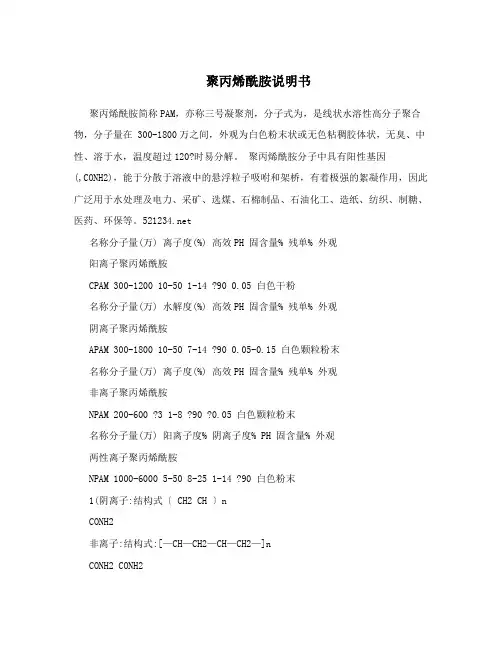
聚丙烯酰胺说明书聚丙烯酰胺简称PAM,亦称三号凝聚剂,分子式为,是线状水溶性高分子聚合物,分子量在 300-1800万之间,外观为白色粉末状或无色粘稠胶体状,无臭、中性、溶于水,温度超过120?时易分解。
聚丙烯酰胺分子中具有阳性基因(,CONH2),能于分散于溶液中的悬浮粒子吸咐和架桥,有着极强的絮凝作用,因此广泛用于水处理及电力、采矿、选煤、石棉制品、石油化工、造纸、纺织、制糖、医药、环保等。
名称分子量(万) 离子度(%) 高效PH 固含量% 残单% 外观阳离子聚丙烯酰胺CPAM 300-1200 10-50 1-14 ?90 0.05 白色干粉名称分子量(万) 水解度(%) 高效PH 固含量% 残单% 外观阴离子聚丙烯酰胺APAM 300-1800 10-50 7-14 ?90 0.05-0.15 白色颗粒粉末名称分子量(万) 离子度(%) 高效PH 固含量% 残单% 外观非离子聚丙烯酰胺NPAM 200-600 ?3 1-8 ?90 ?0.05 白色颗粒粉末名称分子量(万) 阳离子度% 阴离子度% PH 固含量% 外观两性离子聚丙烯酰胺NPAM 1000-6000 5-50 8-25 1-14 ?90 白色粉末1(阴离子:结构式〔 CH2 CH 〕nCONH2非离子:结构式:[—CH—CH2—CH—CH2—]nCONH2 CONH2阳离子:结构式:[—CH—CH2—CH—CH2]nCONH2 CONHCH2N(CH3)22(物理特性;本产品为胶体和粉剂。
胶体产品为无色透明、无毒性、无腐蚀。
粉剂为白色粒状或细粉末状固体,两者均能溶于水。
吸水速度随衍生物离子特性的区别而不同。
但几乎不溶于一般溶剂(苯、甲苯、乙醇、乙醚、丙酮、酯类等),仅在乙二醇、甘油、冰醋酸、甲酰胺、乳酸、丙烯酸等溶剂中能溶解1%左右。
不同品种,不同分子量的产品有不同的性质。
3(用途:主要用于采油、制糖、洗煤、选矿、造纸、涂料、湿法冶金,纺织、石料切割、化工、农药、医药以及污水处理等等。
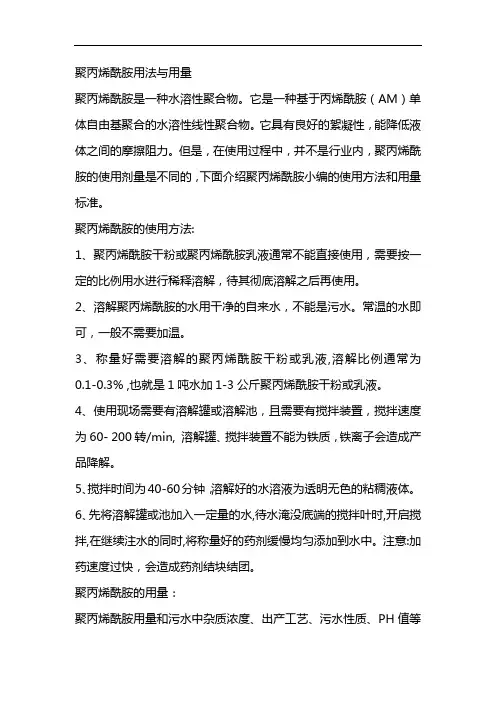
聚丙烯酰胺用法与用量聚丙烯酰胺是一种水溶性聚合物。
它是一种基于丙烯酰胺(AM)单体自由基聚合的水溶性线性聚合物。
它具有良好的絮凝性,能降低液体之间的摩擦阻力。
但是,在使用过程中,并不是行业内,聚丙烯酰胺的使用剂量是不同的,下面介绍聚丙烯酰胺小编的使用方法和用量标准。
聚丙烯酰胺的使用方法:1、聚丙烯酰胺干粉或聚丙烯酰胺乳液通常不能直接使用,需要按一定的比例用水进行稀释溶解,待其彻底溶解之后再使用。
2、溶解聚丙烯酰胺的水用干净的自来水,不能是污水。
常温的水即可,一般不需要加温。
3、称量好需要溶解的聚丙烯酰胺干粉或乳液,溶解比例通常为0.1-0.3% ,也就是1吨水加1-3公斤聚丙烯酰胺干粉或乳液。
4、使用现场需要有溶解罐或溶解池,且需要有搅拌装置,搅拌速度为60- 200转/min, 溶解罐、搅拌装置不能为铁质,铁离子会造成产品降解。
5、搅拌时间为40-60分钟,溶解好的水溶液为透明无色的粘稠液体。
6、先将溶解罐或池加入一定量的水,待水淹没底端的搅拌叶时,开启搅拌,在继续注水的同时,将称量好的药剂缓慢均匀添加到水中。
注意:加药速度过快,会造成药剂结块结团。
聚丙烯酰胺的用量:聚丙烯酰胺用量和污水中杂质浓度、出产工艺、污水性质、PH值等情况决定用量的,没有固定的用量,不异行业也只是可以参考利用何种型号的产物。
下面我推荐聚丙烯酰胺用量的示例仅供供参考:一、阳离子聚丙烯酰胺用量1、用于污泥脱水时,配比浓度建议为0.2%,溶解搅拌时间建议为50分钟。
2、上机前,需进行小试确定比例。
建议取100ml污水样,将其溶液用注射器每次打入0.5ml。
不断搅拌观察,查看污水絮凝效果、絮凝速度、上清液状况、沉淀效果等,确定投加量。
3、在造纸厂、化工污水、污水处理厂家、洗煤厂应用时,固体干粉用量为10-20g/每吨污水。
二、阴离子聚丙烯酰胺用量1、用于污水处理絮凝沉淀时,建议浓度配比为0.1%。
2、建议搅拌时间为40分钟,转速控制在40-60转/分钟。
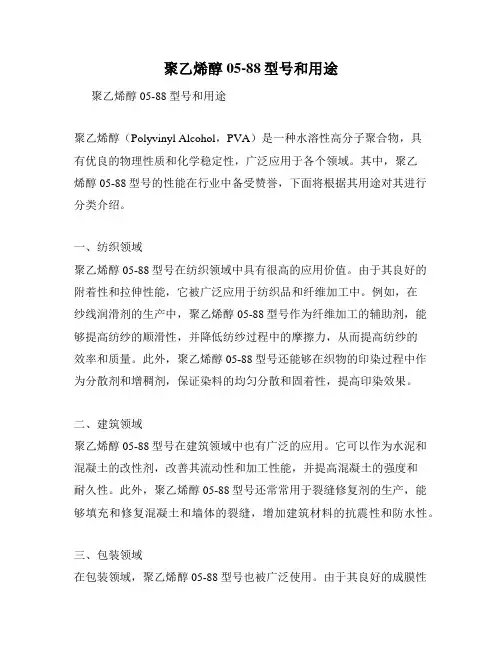
聚乙烯醇05-88型号和用途聚乙烯醇05-88型号和用途聚乙烯醇(Polyvinyl Alcohol,PVA)是一种水溶性高分子聚合物,具有优良的物理性质和化学稳定性,广泛应用于各个领域。
其中,聚乙烯醇05-88型号的性能在行业中备受赞誉,下面将根据其用途对其进行分类介绍。
一、纺织领域聚乙烯醇05-88型号在纺织领域中具有很高的应用价值。
由于其良好的附着性和拉伸性能,它被广泛应用于纺织品和纤维加工中。
例如,在纱线润滑剂的生产中,聚乙烯醇05-88型号作为纤维加工的辅助剂,能够提高纺纱的顺滑性,并降低纺纱过程中的摩擦力,从而提高纺纱的效率和质量。
此外,聚乙烯醇05-88型号还能够在织物的印染过程中作为分散剂和增稠剂,保证染料的均匀分散和固着性,提高印染效果。
二、建筑领域聚乙烯醇05-88型号在建筑领域中也有广泛的应用。
它可以作为水泥和混凝土的改性剂,改善其流动性和加工性能,并提高混凝土的强度和耐久性。
此外,聚乙烯醇05-88型号还常常用于裂缝修复剂的生产,能够填充和修复混凝土和墙体的裂缝,增加建筑材料的抗震性和防水性。
三、包装领域在包装领域,聚乙烯醇05-88型号也被广泛使用。
由于其良好的成膜性和可溶性,它能够制备出具有良好柔韧性和透明度的薄膜,用于包装食品、药品和化妆品等。
此外,聚乙烯醇05-88型号还能够作为粘合剂,用于纸张、纤维和塑料薄膜的粘合,提高包装材料的强度和稳定性。
四、制浆造纸领域在制浆造纸领域,聚乙烯醇05-88型号也发挥着重要的作用。
它可以作为湿强剂添加到造纸工艺中,改善纸张的湿强度和撕裂强度,提高纸张的质量和使用寿命。
此外,聚乙烯醇05-88型号还能够作为纸张的表面涂布剂,提供纸张的光泽度和平滑度。
综上所述,聚乙烯醇05-88型号在纺织、建筑、包装和制浆造纸领域中都有着广泛的应用。
其卓越的性能使得它在这些领域中成为不可或缺的材料。
随着科学技术的不断发展,相信聚乙烯醇05-88型号在更多的领域中将有更广阔的应用前景。
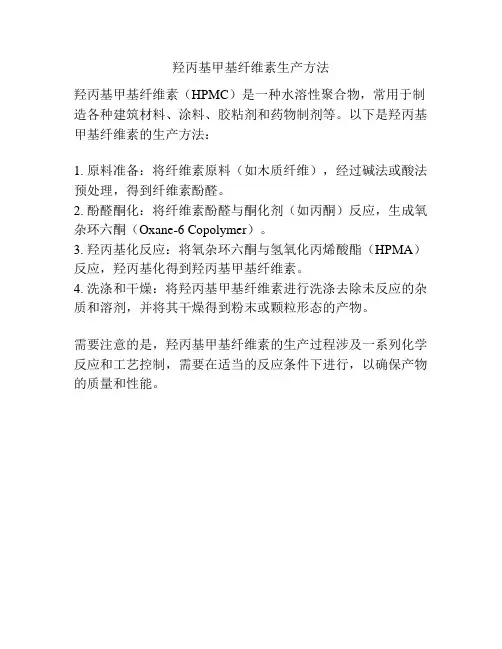
羟丙基甲基纤维素生产方法
羟丙基甲基纤维素(HPMC)是一种水溶性聚合物,常用于制造各种建筑材料、涂料、胶粘剂和药物制剂等。
以下是羟丙基甲基纤维素的生产方法:
1. 原料准备:将纤维素原料(如木质纤维),经过碱法或酸法预处理,得到纤维素酚醛。
2. 酚醛酮化:将纤维素酚醛与酮化剂(如丙酮)反应,生成氧杂环六酮(Oxane-6 Copolymer)。
3. 羟丙基化反应:将氧杂环六酮与氢氧化丙烯酸酯(HPMA)反应,羟丙基化得到羟丙基甲基纤维素。
4. 洗涤和干燥:将羟丙基甲基纤维素进行洗涤去除未反应的杂质和溶剂,并将其干燥得到粉末或颗粒形态的产物。
需要注意的是,羟丙基甲基纤维素的生产过程涉及一系列化学反应和工艺控制,需要在适当的反应条件下进行,以确保产物的质量和性能。
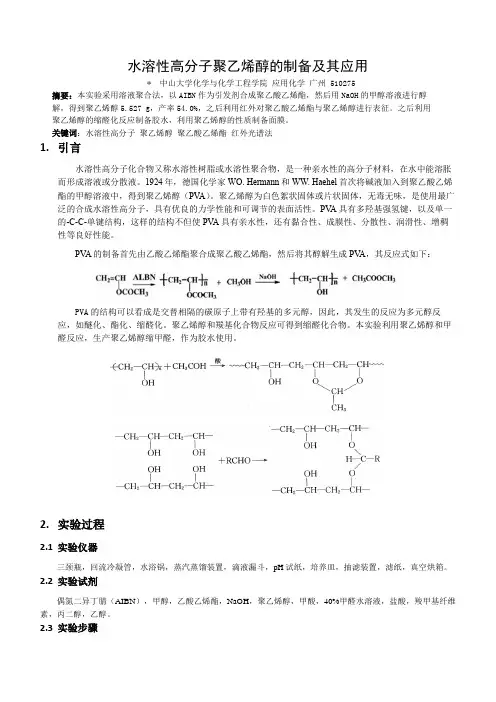
水溶性高分子聚乙烯醇的制备及其应用* 中山大学化学与化学工程学院应用化学广州 510275摘要:本实验采用溶液聚合法,以AIBN作为引发剂合成聚乙酸乙烯酯,然后用NaOH的甲醇溶液进行醇解,得到聚乙烯醇5.527 g,产率54.0%,之后利用红外对聚乙酸乙烯酯与聚乙烯醇进行表征。
之后利用聚乙烯醇的缩醛化反应制备胶水,利用聚乙烯醇的性质制备面膜。
关键词:水溶性高分子聚乙烯醇聚乙酸乙烯酯红外光谱法1.引言水溶性高分子化合物又称水溶性树脂或水溶性聚合物,是一种亲水性的高分子材料,在水中能溶胀而形成溶液或分散液。
1924年,德国化学家WO. Hermann和WW. Haehel首次将碱液加入到聚乙酸乙烯酯的甲醇溶液中,得到聚乙烯醇(PV A)。
聚乙烯醇为白色絮状固体或片状固体,无毒无味,是使用最广泛的合成水溶性高分子,具有优良的力学性能和可调节的表面活性。
PV A具有多羟基强氢键,以及单一的-C-C-单键结构,这样的结构不但使PV A具有亲水性,还有黏合性、成膜性、分散性、润滑性、增稠性等良好性能。
PV A的制备首先由乙酸乙烯酯聚合成聚乙酸乙烯酯,然后将其醇解生成PV A,其反应式如下:PVA的结构可以看成是交替相隔的碳原子上带有羟基的多元醇,因此,其发生的反应为多元醇反应,如醚化、酯化、缩醛化。
聚乙烯醇和羰基化合物反应可得到缩醛化合物。
本实验利用聚乙烯醇和甲醛反应,生产聚乙烯醇缩甲醛,作为胶水使用。
2.实验过程2.1 实验仪器三颈瓶,回流冷凝管,水浴锅,蒸汽蒸馏装置,滴液漏斗,pH试纸,培养皿,抽滤装置,滤纸,真空烘箱。
2.2 实验试剂偶氮二异丁腈(AIBN),甲醇,乙酸乙烯酯,NaOH,聚乙烯醇,甲酸,40%甲醛水溶液,盐酸,羧甲基纤维素,丙二醇,乙醇。
2.3 实验步骤2.3.1聚合反应往装有回流冷凝管的三颈瓶中加入0.03 g (0.18 mmol )AIBN ,20 g (22 mL )乙酸乙烯酯和10 mL 甲醇,开动搅拌。

聚乙烯醇聚乙烯醇(简称PV A)最早由德国的化学家赫尔曼(W.O.Hemnann)和海涅尔(W.Hachnel)于1924年发明的。
1951年我国已经从事PV A的研究和开发工作,20世纪70年代市场上出现了PV A商品。
由于合成技术的不断提高和价格不断下降,它的用途日益广泛,发展速度很快。
聚乙烯醇是通过醋酸乙烯酯聚合制得聚醋酸乙烯酯(PvAC),然后再醇解或者水解得到的。
由于羟基基团的存在,使PvA有很高的吸水性,是一种性能优良,用途广泛的水溶性聚合物。
聚乙烯醇为一种可溶性树脂,一般用作纺织浆料,粘合剂、建筑等行业。
也可通过改性制成薄膜,用来制作可降解的地膜、保鲜膜等。
聚乙烯醇的最大特点就是可以自然降解,环境友好。
1聚乙烯醇的性质聚乙烯醇一般为白色或微黄色,为絮片状、颗粒状、粉末状固体。
无毒无味,性能介于塑料和橡胶之间。
PV A溶液遇碘液变深蓝色,这种变色受热后消失而冷却又重现。
由于分子链上含有大量的侧基一羟基,具有良好的水溶性,同时还具有良好的成膜性、粘接力和乳化性,有卓越的耐油脂和耐溶剂性能。
聚乙烯醇的相对密度为(25℃/4℃)1.27~1.31(固体)、1.02(10%溶液),熔点230℃,玻璃化温度75-85℃,在空气中加热至100℃以上慢慢变色、脆化。
加热至160一170℃脱水醚化,失去溶解性,加热到200℃开始分解。
超过250℃变成含有共轭双键的聚合物。
折射率1.49"-'1.52,热导率0.2w/(m·K),比热容l~5J/(kg·K),电阻率(3.1~3.8)×107 Ώ·cm。
解度为97%~98%时这种影响变得十分明显。
1.2PV A水溶液的性质从表1.1可知,当聚乙烯醇的水溶液浓度为1%~5%时,在室温下放置较长时间或长时间加热,其粘度不下降,说明没有解聚现象。
当溶液浓度增高时,粘度也有所升高,长时间静置后可出现凝胶,因为放置后形成了超分子结构。
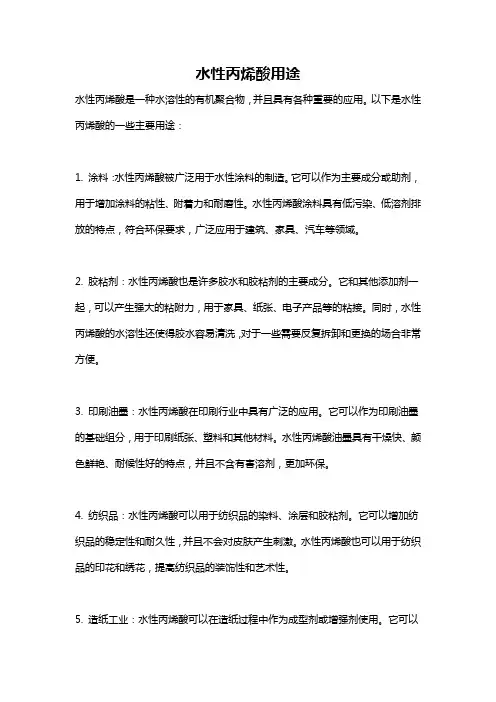
水性丙烯酸用途水性丙烯酸是一种水溶性的有机聚合物,并且具有各种重要的应用。
以下是水性丙烯酸的一些主要用途:1. 涂料:水性丙烯酸被广泛用于水性涂料的制造。
它可以作为主要成分或助剂,用于增加涂料的粘性、附着力和耐磨性。
水性丙烯酸涂料具有低污染、低溶剂排放的特点,符合环保要求,广泛应用于建筑、家具、汽车等领域。
2. 胶粘剂:水性丙烯酸也是许多胶水和胶粘剂的主要成分。
它和其他添加剂一起,可以产生强大的粘附力,用于家具、纸张、电子产品等的粘接。
同时,水性丙烯酸的水溶性还使得胶水容易清洗,对于一些需要反复拆卸和更换的场合非常方便。
3. 印刷油墨:水性丙烯酸在印刷行业中具有广泛的应用。
它可以作为印刷油墨的基础组分,用于印刷纸张、塑料和其他材料。
水性丙烯酸油墨具有干燥快、颜色鲜艳、耐候性好的特点,并且不含有害溶剂,更加环保。
4. 纺织品:水性丙烯酸可以用于纺织品的染料、涂层和胶粘剂。
它可以增加纺织品的稳定性和耐久性,并且不会对皮肤产生刺激。
水性丙烯酸也可以用于纺织品的印花和绣花,提高纺织品的装饰性和艺术性。
5. 造纸工业:水性丙烯酸可以在造纸过程中作为成型剂或增强剂使用。
它可以提高纸张的强度和抗张力,同时改善纸张的水分吸收性能。
水性丙烯酸还可以作为润湿剂,帮助纸张更好地吸收墨水和涂料。
6. 包装材料:水性丙烯酸在包装材料制造方面起到了重要的作用。
它可以用于制造水性丙烯酸胶带、保鲜膜、包装膜等。
水性丙烯酸胶带具有优异的粘附力和耐用性,被广泛应用于快递包装、商业包装等领域。
此外,水性丙烯酸还被应用于涂饰、汽车涂料、海洋涂料等领域。
随着环保意识的提高,水性丙烯酸作为一种低溶剂、低VOC的涂料材料,具有广阔的发展前景和市场潜力。
它不仅满足了人们对环境友好性的要求,还具有较高的质量和性能,逐渐替代传统的溶剂性涂料成为主流。
cmc羧甲基纤维素钠熔点
CMC羧甲基纤维素钠是一种水溶性聚合物,其熔点并不明显,因为它在加热时并不会熔化,而是在一定温度范围内逐渐分解。
一般来说,CMC羧甲基纤维素钠的热分解温度在200摄氏度左右,但这并不是它的熔点,因为它并不是通过熔化来改变其物理状态的。
实际上,CMC羧甲基纤维素钠主要是在加热时发生热分解,而不是像普通的聚合物那样通过熔化来改变其形态。
另外,CMC羧甲基纤维素钠的性质还受到其分子量、取代度等因素的影响,不同的CMC羧甲基纤维素钠可能具有不同的热性质。
因此,要准确了解特定CMC羧甲基纤维素钠的热性质,需要查阅该化合物的具体技术资料或者进行实验测试。
总的来说,CMC羧甲基纤维素钠并不像普通的聚合物那样具有明显的熔点,而是在一定温度范围内发生热分解,因此其热性质相对复杂,需要具体情况具体分析。
脂溶性和水溶性的区别
【示例范文仅供参考】
---------------------------------------------------------------------- 脂溶性和水溶性的区别:
1、脂溶性是指物质能在非极性溶剂中溶解的性能。
脂溶性物质的分子中通常带有较长的碳链。
2、水溶性狭义地讲指物质在水中的溶解性质,广义地讲指物质在极性溶剂中的溶解性质。
具有水溶性的物质分子中通常含有极性基团如-OH、-NHR、-COOH等或不太长的碳链。
水溶性聚合物的用途:
1、用于污泥脱水根据污泥性质可选用本产品的相应型号,可有效在污泥进入压滤之前进行污泥脱水,脱水时,产生絮团大,不粘滤布,压滤时不散,流泥饼较厚,脱水效率高,泥饼含水率在80%以下。
2、用于生活污水和有机废水的处理,本产品在配性或碱性介质中
均呈现阳电性,这样对污水中悬浮颗粒带阴电荷的污水进行絮凝沉淀,澄清很有效。
3、用于以江河水作水源的自来水的处理絮凝剂,用量少,效果好,成本低,特别是和无机絮凝剂复合使用效果更好,它将成为治长江、黄河及其它流域的自来水厂的高效絮凝剂。
4、造纸用增强剂及其它助剂。
提高填料、颜料等存留率、纸张的强度。
5、用于油田经学助剂,如粘土防膨剂,油田酸化用稠化剂。
6、用于纺织上浆剂、浆液性能稳定、落浆少、织物断头率低、布面光洁。
引言自从人类进入高分子时代,塑料制品便大量涌现,给人们的生活带来「极大的便利。
但是,塑料却通常难以自然降解,大量的塑料造成了白色污染,对环境具有极大的危害.而有这么一种塑料,遇水能够变成累状物,最终完全溶解在水中,可以有效减少对环境的污染,这种神奇的可溶解塑料便是我们今天的主角一一聚乙烯号(PVA).聚乙烯醇PVA〃简介聚乙烯醉,简称PVA,是一种白色, 稳定无毒的水溶性高分子聚合物,可呈现粉末状、片状或紫状。
聚乙烯醉以碳碳为主链,分子链上含有大量的亲水基团羟基,在化学结构上可以看作是碳原子上带有羟基的多元酹,因此PVA能发生多元醉的经典反应,如酸化、酷化、缩醉化等。
PVA通常聚由醇酸乙烯脂经过醇解反应制得,因此可以呈现出头-尾结构,进行缩甲羟化〃溶解性能溶解性能聚乙烯静的使用大多基于它的水溶液。
由于聚乙烯醇分子中含有大量的亲水基团羟基,可以形成分子间里键,使之具有水溶性。
但是聚乙烯酹规整的化学结构使其分子间、分子内都存在着较强的氢篌,一定程度上阻碍了它的溶解性,而残存的曲峻根使得分子间的空间位阻增大,破坏了大分子的规盛结构,使水分子容易接近PVA,促进其溶解,所以错酸根的存在对聚乙烯醇的溶解性是有利的。
思考:高分子的溶解性还与哪些因素有关呢?生物可降解性聚乙烯醇是唯•可以被细菌作为碳源和能源利用的乙烯基聚合物,在细菌和的的作用下,46天可以降解75%,所以也是一种生物可降解高分子材料,因其是介于塑料和橡胶之间的树脂高分子•,使得他在环保方面有着重要地位,是可持续发展战略必不可少的绿色材料。
改性产品:洗衣凝珠材料医用研究经过改性的聚乙烯醇具有广泛的应用。
由于PVA具有无毒、无剌激、可生物降解等特性,在制药学中可作为药物释放的栽体。
因其良好的亲水性和分散性,能够均匀地分散在水泥基质中,被用作建筑水泥材料。
速溶性的聚乙烯醇产生的薄膜可以用作特殊的包装材料,例如生活中常用的洗衣凝珠,外层塑料包裹遇水便可溶解样放内部的清洁剂。
第8期化学世界·437·水溶性疏水缔合聚合物单体的合成钟传蓉1’2,黄荣华1,代华1(1.四川大学高分子研究所,高分子材料工程国家重点实验室,四川成都610065,2.成都理工大学材料与生物工程学院,四川成都610059)摘要:水溶性疏水缔合聚合物含有大量的亲水基团和少量的疏水基团,疏水基团间的疏水缔合作用使这种聚合物具有独特的增粘、抗剪切、耐温和耐盐的溶液性能,通常采用亲水单体和疏水单体共聚制备这类聚合物。
对常用亲水单体AMPS及各类疏水单体如季铵盐不饱和单体AMPDAC 和DAMAB、长链丙烯酸酯,Ⅳ一烷基丙烯酰胺和.Ⅳ一芳烷基丙烯酰胺的合成进行了综述。
关键词:单体;N一烷基丙烯酰胺;合成;疏水缔合聚合物;水溶性中图分类号:0 631.5 文献标识码:A 文章编号:0367—6358(2004)08—0437—05Synthesis of Monomers of Water—solubleHydrophobically Associating PolymersZ H O N G Chuan—ron91”。
H U A N G Rong—hual,DA I Hual(J.Pol yme r R es e a r c h Institute of S ic h u an U n i ve r gi t y,T he S ta t e K e y L ab o r at o r y of Polyme r Materials Engineering,Sich uan C hen gdu 610065,Ch ina l Z Material a n d B io e n g i ne e r i n g C ol l eg e of C h e n g d u University of T e ch no lo g y,Sic hua n Ch en gdu61 0059 Ch i na)Abstract:Hydrophobicall y associating wa te r-s ol ub le copolymers c on ta in many water-s ol ubl e g r o u p s and few hydrophobic groups.The copolymers sh ow e xc ell en t s ol ut io n pr op er ti es,su ch a s viscosifying,antis—hearing,antielectrolyte and heat—resisting p ro pe r ti es,b ec a us e of,the hydrop ho bic al ly a ss oc ia tin g effect.A sso ciat ing polymers a r e prepare d by t h e copolymer izat ion of w ater-solu ble and hydrophobi c monome rs.The syn t he s e s of water—solubl e mon ome r AM PS and h y dr op h ob i c monom ers inc lu di n g AMPDAC,DAM—AB,咒一a l ky l acrylates,N—alkyl acrylamides a n d N—arylalkyl acr yla mi des a r e re vi e w e d.Key words:mo nome rs;N—alky lacr yla mide s;s ynt hesi s;h ydr opho bica lly as s o c ia t i n g polymers;water—solu—b l e水溶性疏水缔合聚合物除含有大量的亲水极性发生在分子链之间,也可能发生在同一大分子链内。
Polyethylene Glycol 3350 用法Polyethylene glycol 3350(聚乙二醇3350)是一种水溶性聚合物,常用于治疗便秘和减轻肠道疾病症状。
它是一种非处方药,可通过口服或灌肠的方式使用。
本文将详细介绍Polyethylene glycol 3350的用法以及相关注意事项。
1. Polyethylene glycol 3350的作用机制Polyethylene glycol 3350是一种渗透性泻药,通过增加粪便中的水分含量来增强肠道蠕动,并软化和润滑粪便,从而促进排便。
它不被肠道吸收,也不会对肠道产生刺激性影响。
2. Polyethylene glycol 3350的用法口服剂型•治疗成人便秘:每日剂量为17克(1包),溶解于4至8盎司(约120至240毫升)清水中,并在饭前或饭后直接饮用。
•治疗儿童便秘:儿童剂量根据年龄而定,通常为每日0.2克/公斤体重(最大剂量不超过17克),溶解于4至8盎司(约120至240毫升)清水中,并在饭前或饭后直接饮用。
灌肠剂型•治疗便秘:将17克(1包)Polyethylene glycol 3350溶解于约1夸脱(约946毫升)温水中,然后用灌肠器将溶液缓慢注入直肠。
保持体位,尽量延长灌肠液在肠道内的停留时间。
3. Polyethylene glycol 3350的注意事项•使用前请仔细阅读药品说明书,并遵循医生或药剂师的指导。
•Polyethylene glycol 3350只适用于短期使用,如果便秘持续超过7天,请咨询医生。
•对Polyethylene glycol 3350过敏者禁止使用。
•孕妇和哺乳期妇女应在医生指导下使用。
•长期高剂量使用可能会导致电解质紊乱,如低钠血症。
请密切监测体征和症状,并遵循医生的建议。
•如果出现严重的腹泻、呕吐、腹部胀气或其他不适症状,请立即停止使用,并咨询医生。
•Polyethylene glycol 3350可能与其他药物相互作用,包括药物吸收的影响。
聚乙烯醇的简介聚乙烯醇(简称PVA)外观为白色粉末,是一种用途相当广泛的水溶性高分子聚合物,性能介于塑料和橡胶之间,它的用途可分为纤维和非纤维两大用途。
由于PVA具有独特的强力粘接性、皮膜柔韧性、平滑性、耐油性、耐溶剂性、保护胶体性、气体阻绝性、耐磨性以及经特殊处理具有的耐水性,因此除了作纤维原料外,还被大量用于生产涂料、粘合剂、纸品加工剂、乳化剂、分散剂、薄膜等产品,应用范围遍及纺织、食品、医药、建筑、木材加工、造纸、印刷、农业、钢铁、高分子化工等行业。
聚乙烯醇的合成方法乙烯直接合成法石油裂解乙烯直接合成法,由日本可乐丽公司(原仓敷人造丝公司)首次开发成功并用于工业化生产。
目前,国际上生产PVA的工艺路线以乙烯法占主导地位,其数量占总生产能力的72%。
美国已完成了乙炔法向乙烯法的转变,日本的乙烯法也占70%以上,而中国的生产企业只有两家为乙烯法。
其工艺流程包括:乙烯的获得及醋酸乙烯(VAc)合成、精馏、聚合、聚醋酸乙烯(PVAc)醇解、醋酸和甲醇回收五个工序。
石油乙烯法的工艺特点:生产规模较乙炔法大,产品质量好,设备易于维护、管理和清洗、热利用率高,能量节约明显,生产成本较乙炔法低30%以上。
天然气裂解乙炔直接合成法乙炔合成法依其原料的来源不同可分为电石乙炔合成法和天然气裂解乙炔合成法。
电石乙炔合成法电石乙炔合成法,最早实现工业化生产。
电石乙炔法工艺特点:操作比较简单、产率高、副产物易于分离,因而国内至今仍有10家工厂沿用此法生产,且大部分应用高碱法生产。
但由于此种工艺路线产品能耗高、质量低、成本高,生产过程产生的杂质污染环境亦较为严重,成本高于其他二法生产的PVA 800~1 000元/t,缺乏市场竞争力,属逐渐淘汰工艺。
国外先进国家早于20世纪70年代已全部用低碱法生产工艺。
天然气裂解乙炔乙炔直接合成法在天然气、煤和电力丰富的地区,天然气乙炔法仍具有生命力。
欧洲及朝鲜等国家以天然气乙炔法为主,中国有一套生产装置用此法。